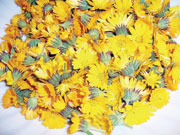WHO would think of adding bright yellow marigolds to a potato salad? Their presence adds not only color and pizzazz but a welcome spicy flavor to this common dish. Marigolds which grow wild in Central Europe, were originally used as a “pot herb” to season meats and salads. Many of us might feel ill at ease about eating flowers yet we have enjoyed them without even knowing it.
Artichokes and broccoli are in fact immature flowers and many herbal teas are made of familiar flowers such as hibiscus, mint, camomile, linden or jasmine.
Throughout history, many different cultures have incorporated flowers into their traditional foods. The earliest records of the culinary use of flowers date back to 140 BC. In fact, flowers were first cultivated for food.
In prehistoric Mexico people ate the starchy roots of dahlias. Native Americans gathered many varieties of greens and flowers in the spring and early summer months and they ate them raw. From archeology and other documents we know the Chinese ate edible flowers such as lotus, magnolia, peonies and daylilies. The pale gold lily flowers with their musky taste are still used in Chinese cooking as a vegetable or flavoring with fish and poultry. Traditional cuisines of the subcontinent flavor many sweets and puddings with rose water and the essence of kewra, the screw pine which bears highly fragrant flowers similar to that of roses.
The scents of rose and orange blossom are also widely used in Arabic desserts. Orange blossom water and rose water lend a delicate perfume to syrups, pastries and puddings. A teaspoon in a coffee cup of boiling water, with or without sugar makes the soothing and digestive ‘white coffee’ of Lebanon.
The ancient Romans also included roses and violets in their culinary repertoire. Brains were flavored with rose petals and hashes with sweet marjoram flowers. Italian gastronomy is known today for its delightful stuffed squash blossoms. In Elizabethan England violets were eaten raw with onions and lettuce or mixed in broths. Violets were also made into a syrup which was poured over puddings and cakes.
During the Middle Ages in Europe, flower fritters made with violets, elderflowers and lilies were very popular.
In France, mimosa, an ornamental species of acacia with yellow flowers, is still made into fritters.
Sweet delicacies such as candied violets, candied mimosa, candied forget-me-not and praline-flavored orange blossoms were popular during the 19th century.
The French town of Provins is still a center of rose-flavored confectionery: rose petal jam, rose-flavored candy, rose jelly and crystallized rose petals. Toulouse, also in France is reputed for its crystallized violets.
Efforts to reintroduce flowers into western cooking began in the 20th century. Jules Maincave, a famous French chef complained that seasonings were “pitifully limited, whereas the progress of modern chemistry would enable us to use rose, lilies and lily-of-the-valley.”
The most innovative ideas however started on America’s West Coast. Since the 1970’s there has been an increasing awareness and interest in edible flowers. A growing number of creative chefs are including flowers in their recipes.
One of the easiest flower recipes is Flower Sugar. Petals of roses, scented geranium, lilac, lavender or pansies and granulated sugar are ground in a food processor then placed in airtight containers. The sugar can be used in a week.
Some of the most common edible flowers are calendula, chives, and daylily, mint, nasturtium, pansy, rose, sage, marigold and squash blossoms.
They taste good, cover the color spectrum and can be used in a wide variety of recipes from appetizers to desserts thanks to their broad range of flavors: nasturtium (spicy), squash and daylily (vegetal), chives (oniony), calendula (bitter), pansies (minty); the rose has a delightful floral tang while sage and marigolds have a herbal taste.
The beautiful orange calendula has been called “ poor man’s saffro “ as powdered calendula petals are an excellent substitute. Along with the red poppy, nasturtium, borage, violet and honeysuckle, calendula are used in salads for their beautiful colors.
Vinegar, however, changes the color of flowers; therefore if you wish to dress the salad with vinaigrette the flowers should be added at the last moment and the salad tossed when it is time to serve.
Cooking with flowers is becoming once again an artful way to add flavor and color to gastronomy. There are certain rules to be followed with edible flowers. Pistils and stamens should be removed and only eat the petals of flowers you are positive are edible and have been grown organically.


